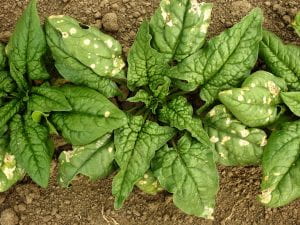Margaret Tuttle McGrath
Plant Pathology and Plant-Microbe Biology Section, SIPS, Cornell University
Long Island Horticultural Research and Extension Center
3059 Sound Avenue, Riverhead, NY 11901; mtm3@cornell.edu
Detection of Stemphylium leaf spot in spinach during June 2019 on Long Island is the second confirmed case in the Northeast. Previous occurrence was western NY in 2017. First occurrences in the USA were in Salinas Valley, CA, starting in 1997. Subsequently it was reported in a few other states including DE, MD, AZ, TX and FL where recently it has been a major problem especially in baby leaf spinach plantings.
This new occurrence might be associated with recent detection of a change in the dominant species of Stemphylium causing this disease (from S. botryosum or S. beticola to S. vesicarium).
Pathogen source. Contaminated seed is the likely source of the pathogen for the occurrence on Long Island. Stemphylium botryosum was detected in all 89 seed lots tested from four countries during a study in 2000 to 2003. The pathogen was found to be both inside and on the surface of seed, and still viable in 11-year-old seed. Symptoms indicative of seed transmission were observed on the tips of cotyledons. Fortunately, seed transmission was found to occur at a low rate. This could at least partly account for most reported occurrences having been in large, very dense plantings typical for baby leaf spinach production.
This pathogen is not expected to survive between spinach crops because its spore type that enables it to survive on debris has only been found on spinach stems, thus only a concern in seed production fields, and is not otherwise capable of surviving in soil.
Symptoms are light gray to tan leaf spots ranging in size from about 1/16th of an inch to 1/2 an inch with larger spots being irregular in shape. Initially spots can be gray-green. They start to appear as soon as 3 days (80 hrs) after infection based on results from inoculation with S. botryosum done under controlled conditions. As spots age they dry up and become papery in texture.
Stemphylium leaf spot has been reported to start developing from foci. Symptoms were found throughout the small planting on Long Island likely reflecting the fact it was established with transplants. If initial infection occurred when seedlings were in the greenhouse, their close proximity and daily overhead watering could have created ideal conditions for pathogen spread.
Favorable conditions are prolonged periods of leaf wetness when temperatures are moderate (64-75 F). There were frequent rain events during spring on Long Island in 2019.
All growers with spinach should routinely check their plants for symptoms, especially during favorable conditions. Please report suspect occurrences of Stemphylium leaf spot to local extension specialist and send an e-mail with image of symptoms to mtm3@cornell.edu, who is also the contact about providing samples of affected plants, which are wanted for research to gain better understanding of this disease and the causal pathogens especially in the Northeast region.
References
- du Toit, L. J., and Hernandez-Perez, P. 2005. Efficacy of hot water and chlorine for eradication of Cladosporium variabile, Stemphylium botryosum, and Verticillium dahliae from spinach seed. Plant Dis. 89:1305-1312.
- Everts, K. L., and Armentrout, D. K. 2001. Report of leaf spot of spinach caused by Stemphylium botryosum in Maryland and Delaware. Plant Dis. 85:1209.
- Hernandez-Perez, P. 2005. Management of seedborne Stemphylium botryosum and Cladosporium variabile causing leaf spot of spinach seed crops in western Washington. M.S. thesis. Washington State University, Pullman.
- Hernandez-Perez, P., and du Toit, L. J. 2006. Seedborne Cladosporium variabile and Stemphylium botryosum in spinach. Plant Dis. 90:137-145.
- Koike, S. T., Henderson, D. M., and Butler, E. E. 2001. Leaf spot disease of spinach in California caused by Stemphylium botryosum. Plant Dis. 85:126-130.
Below: Symptoms of Stemphylium leaf spot were found throughout this small planting of spinach in June 2019. Symptomless young leaves in the field pictures, which were taken a week after the picture of individual leaves, may reflect a preceding rain-free period. The grower commented this was not the case the previous week. Older leaves are also considered more susceptible. Diagnostic spores of Stemphylium were observed on a few spots after the leaves were incubated overnight under high humidity in a plastic box.





